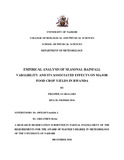| dc.description.abstract | Droughts are common in the lowland areas in the east of Rwanda while floods are frequently
observed in the high grounds to the west and north of the country, which may lead to severe
negative effects on agriculture during extreme climate conditions.
This study aims at investigating how the variability in seasonal rainfall affects the yield of the
major food crops in the country.
The daily gridded rainfall dataset known as ENACTS dataset for a period of 37 years (1981 to
2017) and crop yields data for 12 years (2006 to 2017) on maize and 9 years (2009 to 2017) on
beans were used. The data were analyzed using rotated empirical orthogonal function in order to
delineate near homogeneous rainfall zones over Rwanda. Furthermore, the analysis of the temporal
variability of rainfall onset and/cessation, rainfall amount, frequency and intensity were carried
out for each delineated zones. Later, maize and beans temporal variability were studied. Finally,
the relationship between rainfall and crop yields were investigated using correlation and regression
techniques. Again, the onset/cessation of rainfall in each delineated zone was computed and a
standardized precipitation index was calculated in order to understand temporal variability of
rainfall amount and frequency. Mann – Kendall and Sen’s slope estimates statistics was computed
in order to quantify the magnitude of change in rainfall and its trend
The results indicated that there are ten near homogeneous rainfall zones during the short rains
season and nine near homogeneous rainfall zones during the long rains for the 37 years period of
seasonal rainfall datasets from 1981 to 2017 over Rwanda. The early onset was found in the zones
surrounding the high mountains of Crete Congo Nile, which is in agreement with the migration of
the ITCZ during the short and long rains season. The mean seasonal length exceed three months
over the western and below two months over the eastern during the long rains season. A shortage
in crop yields were recorded over studied zones of Rwanda from 2014 to 2017 with extreme
shortage during 2016 and 2017 years. A strong and significant correlation between monthly
rainfall amount and crop yields was found over the central plateau (Rugobagoba and Gisanga
stations) of Rwanda which means that sufficient rainfall amount for food production is available.
A drying trend in rainfall was found over almost all rainfall zones. Strategies to improve on food
security needs to be envisaged in all zones especially those with more drying trends. | en_US |



